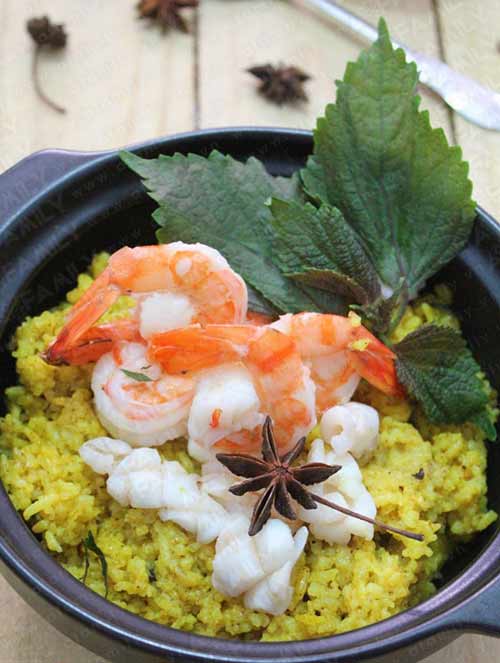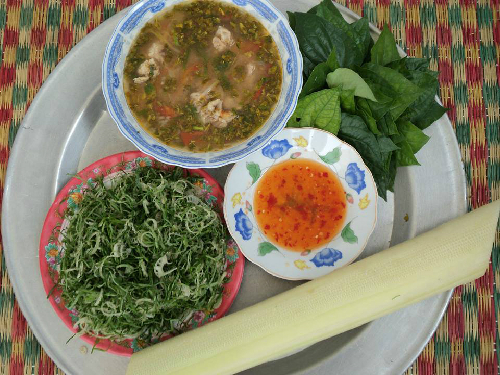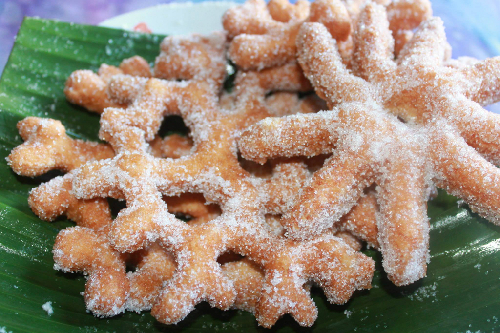After a lot of article writing about the food of King ethnic group in Vietnam, today, we would like to introduce the culinary culture of Cham people. The Cham people prefer boiled and grilled to fried dishes. Their food tastes cool, sour or spicy depending on each season.
Savory
The Cham people like canh boi, a kind of mixed soup containing wild vegetables such as Corchorus leaves, moss rose, ca dia…
Sour soup is also popular in Cham cuisine culture. Indispensable ingredient to make sour soup is tender tamarind leaves. They often make sour soup with river fish but snake-head fish is the best. In the rainy season, many full frogs emerge from the mud, the Cham people always process sour soup with bullfrog and ca dia, very tasty.
Coming to Cham village on Kate or Rija Nagar festival, you will have the chance to enjoy the long-standing traditional dish of Cham people. That is flavoured goat meat soup. The soup is served with boiled goat meat, giem (chopped banana bud and piper lolot). Many Cham people prefer goat meat soup than boiled goat meat because they think that the soup contains more nutrients.
Rau mon soup is also a specific dish of Cham cuisine. The soup is often rare and cooked on funeral or bungalow sacrifice feast. It is not easy to make rau mon soup. It requires the cook a good knowledge of traditional Cham food to make a good rau mon soup. It tastes more delicious while still hot. The soup is eaten with boiled bungalow meat and giem.
Dong is a reptile species that appears a lot in Ninh Thuan. Dong salad is the specialty of the Hindu Cham people served with wild curry leaves. Dong’s head and tail are snacks for men. Wild curry leaves are often roasted and ground with salt to eat for days. In addition, many Cham people like to eat sour soup with dong.
Vole is a popular rustic food in Champa. It could be processed into various dishes such as grill, fry…but roasted is the most excellent. Wild vegetables are eaten with vole meat is tender mango leaves, dot lim, dep vegetable.
Cake
The Cham people have a wide range of cake, served mainly for spiritual festivals, wedding. The popular cakes include tapei anung (bánh tét), tapei bilik (bánh ít), tapei coh (bánh cuốn), sakaya, ginraong laya (bánh củ gừng), kadaor (alike bánh đúc).
Taipei anung is similar to Vietnamese Banh tet. It is made from glutinous rice with varied filling such as pork, mung bean, peanuts… Taipei bilik is alike banh it which is made from glutinous flour with a filling of mung bean or coconut. These two cake are served in the almost a traditional festival of Cham people.
Sakaya is a traditional cake that is only available for important guests, aged people or monks. The Cham statement “Banh tet on top-sakaya at the bottom” reflect some extent importance of these two cakes in Cham cuisine culture.
Ginraong laya is a long time cake made from glutinous flour, sugar, egg and barm. The cake has sweet flavour from sugar, rich from the egg and sweet-smelling from ginger. Thus, it is also called ginger cake.
Kadar is similar to banh duc. The Cham people often present Po Aluah Kadaor cake at Bani chancel on Ramadan festival.
In dining manner of the Cham, all people in a family have a meal together and sit in the family hierarchy. The monks must obey strict rules such as no catfish, dead animals… Brahmin monks are not permitted to eat beef, Bani monks can not eat pork, dong meat and other taboos. Cham cuisine is both diverse and distinctive, contributing to creating a difference between Cham cuisine culture from others.


